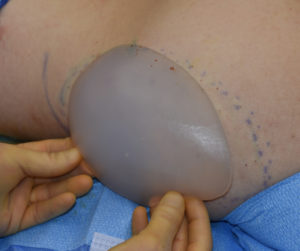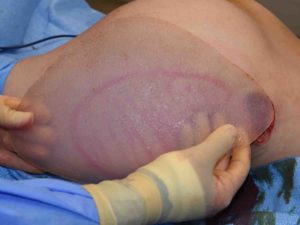The newest member of the body implant family is that of hip implants. Augmentation of the lower torso has been done by various styles of buttock implants for decades. While the majority of buttock augmentation today is done by fat injections (aka Brazilian butt lift), there has been a relative neglect of the hips to the side of the buttocks due to either a lack of adequate fat to inject them or poor fat graft take over the often concave and tighter tissues of the trochanteric hip region.
From an anatomic standpoint, the hip augmentation zone extends from below the superior iliac crest down over the trochanteric tuberosity of the femur bone. Underneath the skin and fat layers lies the tensor fascia late muscle/fascia (TFL) which attaches to the iliac crest and runs continuous with the iliotibial band (ITB) down to the side of the knee where it attaches to the lateral epicondyle. At its superior extent the TFL combines with the posterior ITB to create the upper half of the hip fascia. Posteriorly this thick fascia connects to the gluteus maximus muscle creating an overall continuous sheet. Underneath the ITB inferiorly is the vastus laterals muscle. The function of the TFL is for hip movement specifically abduction, flexion and internal rotation.


Hip augmentation can be successfully done using implants. Currently there are no standard sizes or styles of these body implants. Currently I make all such implants are a custom basis based on patient measurements of surface area coverage.
Dr. Barry Eppley
Indianapolis, Indiana


